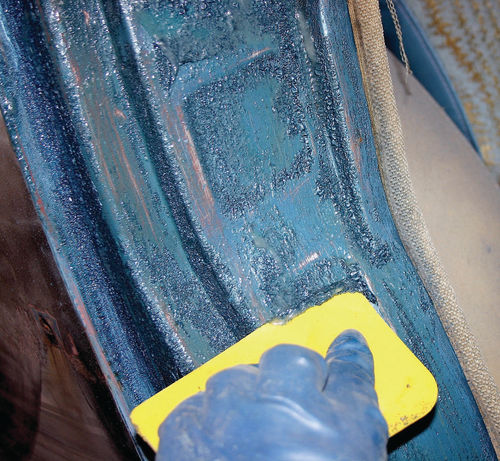Use a stripper instead of blasting
Question:
I am in the middle of restoring a 1956 Ford Victoria. The mechanicals are all done and now I need to paint it. I have removed all the chrome and have taken out the rear window and the windshield thus far. Now I need to know what would be the best way to strip it to bare metal before I take it in for a repaint. I have heard that sandblasting does a good job, but other people say that a chemical stripper is the way to go. Is that true, and if so, which stripper do you recommend, and why?


Answer:
There is abrasive media that can be used for blasting a car, but sand is not one of them. It thins, warps and peens your car’s sheet metal, and in the hands of a novice sandblasting can damage things beyond repair. I have taken a sandblaster to a piece of automotive sheet metal and blasted it at full force to see just what it would do, and it took less than 10 seconds to cut through the panel and make a hole. However, a skilled technician can use garnet or even walnut shells successfully, and soda blasting does a pretty good job too. However, I only strip cars by hand using chemical stripper because it does not damage the metal.
Blue Lightning is my favorite paint stripper and it works well even on cars that have been painted several times. Do keep in mind, though, that this stuff is volatile, nasty and toxic. Wear gauntlet gloves, a long sleeve shirt and a protective mask, plus eye protection, and work outdoors. I can’t stress enough how dangerous this stuff can be if misused.
Before you begin, place a large disposable plastic tarp under your car or car parts table. Don’t smoke, and keep kids and pets well away from your project.
Brush on the stripper in a thick coat and don’t brush back through it because that will make the methyl chloride, which is the active ingredient in the stripper, evaporate too quickly. In fact, on a hot sunny day you may want to cover the stripper with plastic sandwich wrap to slow evaporation.
Let the stripper do its job for about 15 minutes before scraping it off. If it starts to dry out, just slather on more of it. And then use body filler spreaders or putty knives to scrape off the paint. Lacquer basically turns to soup, and enamel becomes like cottage cheese. This powerful stripper will often go down to bare metal on the first application, but may require two or more coats if a car has been painted several times.
I use old newspapers to wipe off the spreaders and clean up, and then place the used paper in a rubbish bin with a lid. In all likelihood you will run across some plastic filler here and there on a car that age. An ordinary propane torch can be used to heat the filler and soften it so you can scrape it out with a putty knife. Don’t be tempted to leave it in place, because the stripper will have ruined it.
When you have stripped an area such as the front fender or hood, wash it down thoroughly with water to get all of the stripper residue off, and then go over it with a disk sander and 300-grit dry sanding disks until you have clean, white metal. This is important because rust can remain in pores in the metal and sabotage your paintwork. Finally, wash the part with rust remover and protectant.
At this point it must be emphasized that you cannot leave stripped bare metal for long, because flashover rust will happen within a few hours and you will have to de-rust the car again before painting it. As soon as the metal is stripped and any rust removed and necessary body work done, you will want to shoot it with waterproof epoxy primer to protect it until you are ready to block sand, reprime, and shoot on the color coats.
If you want a more thorough breakdown on stripping and painting classic cars, you may want to order my book that I did with restorer Tom Horvath called Pro Paint & Body (HP1563) available from Penguin Books or Amazon. It covers every aspect of body and paint and will provide more in-depth coverage than we can offer here.
And if you want a good paint stripper as well as de-rusting and prep solutions, contact:
Blue Lightning Restoration Products
Loma Linda, California
















